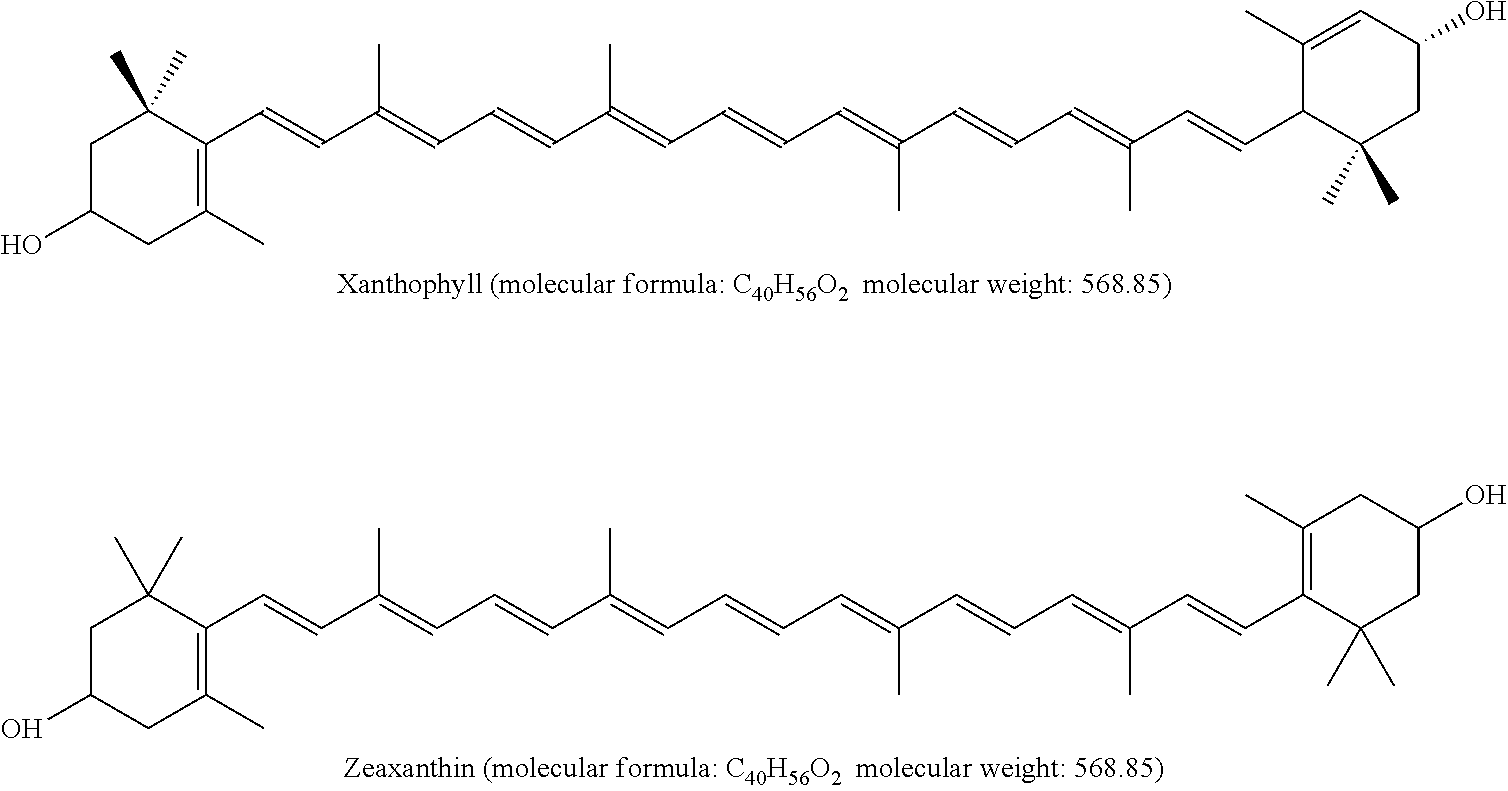Preparing method for xanthophyll crystals with higher content of zeaxanthin from plant oleoresin
a technology of xanthophyll and zeaxanthin, which is applied in the field of carotinoid production, can solve the problems of many unnecessary troubles in the purchase of raw materials, time-consuming, and high cost of raw materials, and achieves the effects of reducing the solubility of carotinoid crystals, promoting isomerization reactions, and reducing the rate of isomerization reactions
- Summary
- Abstract
- Description
- Claims
- Application Information
AI Technical Summary
Benefits of technology
Problems solved by technology
Method used
Image
Examples
implementation example 1
[0046]Mix 1000 g marigold oleoresins (total xanthophyll content is 15.2% in weight) and 2000 mL isopropyl alcohol, heat them to 40° C., stir them until becoming a kind of well distributed flowing solvent, drip 405 mL 45% NaOH solution into them slowly while stirring them, the dripping time is 60 minutes, and let it carry out soap-dissolving 5 hours under this temperature.
[0047]Heat the reaction solution to 60° C., add isopropyl alcohol solution 2400 mL, emulsifier Tween-80 80 g, and then stir the reaction solution 0.5 hour to make it be mixed evenly. Drip 37% CH3ONa solution 240 mL slowly, the dripping time is 1.0 hour, heat it to 70° C. at the same time, and stir it to make it react for 0.5 hour.
[0048]Add 2000 mL deionized water and 200 mL ethyl alcohol after the reaction is completed, keep the temperature of the solution at 60° C. during the dilution process, and stir it slowly for 30 minutes. Separate the gained crystals by centrifugation, the process is quite easy, and it can be...
implementation example 2
[0051]Mix 500 g marigold oleoresins (total xanthophyll content is 14.5%) and 250 mL propyl alcohol, heat them to 85° C., stir them until they become a kind of even flowing solvent, drop 405 mL 45% NaOH solution into them slowly while stirring them, the dropping time is 60 minutes, and let it carry out soap-dissolving 3 hours under this temperature.
[0052]Cool the reaction solution to 60° C., add ethyl acetate solution 1500 mL, emulsifier Span-40 65 g, and then stir it 0.5 hour to make it be mixed evenly. Drop 50% sodium ethoxide solution 100 mL slowly, the dropping time is 1.0 hour, heat it to 80° C. at the same time, and stir it to make it react for 6.0 hour.
[0053]Add 1000 mL deionized water and 250 mL ethyl alcohol after the reaction is finished, keep the temperature of the solution at 60° C. during the dilution process, and stir it slowly for 120 minutes. Separate the gained crystals through filtration, the process is quite easy, and it can be finished within 30 minutes. Wash the ...
implementation example 3
[0056]Mix 1000 g marigold oleoresins (total xanthophyll content is 14.5%) and 2500 mL ethyl alcohol, heat them to 75° C., stir them until they become a kind of well distributed flowing solvent, drip 380 mL 50% NaOH solution into them slowly while stirring them, the dripping time is 60 minutes, and let them carry out soap-dissolving 4 hours under this temperature.
[0057]Cold the reaction solution to 60° C., add propyl alcohol solution 1200 mL, emulsifier Tween-60 60 g, and then stir it 0.5 hour to make them being mixed well distributed. Drip 37% sodium methoxide solution 100 mL slowly, the dropping time is 1.0 hour, heat them to 80° C. at the same time, and stir them to make them to react for 3.0 hour.
[0058]Add 1000 mL deionized water and 250 mL ethyl alcohol after the reaction is finished, keep the temperature of the solution at 60° C. during the dilution process, and stir it slowly for 120 minutes. Separate the gained crystals through pressure filtration, the process is quite easy, ...
PUM
| Property | Measurement | Unit |
|---|---|---|
| temperature | aaaaa | aaaaa |
| temperature | aaaaa | aaaaa |
| temperature | aaaaa | aaaaa |
Abstract
Description
Claims
Application Information
 Login to View More
Login to View More - R&D
- Intellectual Property
- Life Sciences
- Materials
- Tech Scout
- Unparalleled Data Quality
- Higher Quality Content
- 60% Fewer Hallucinations
Browse by: Latest US Patents, China's latest patents, Technical Efficacy Thesaurus, Application Domain, Technology Topic, Popular Technical Reports.
© 2025 PatSnap. All rights reserved.Legal|Privacy policy|Modern Slavery Act Transparency Statement|Sitemap|About US| Contact US: help@patsnap.com

